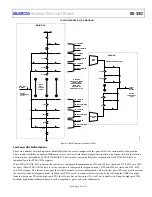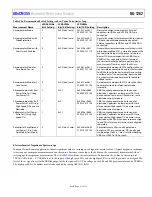
UG-1262
Rev. B | Page 93 of 312
REGISTER DETAILS: LOW POWER TIA/POTENTIOSTAT AND DAC CIRCUITS
LOW POWER TIA CONTROL BITS CHANNEL 0 REGISTER
Address: 0x400C20EC, Reset: 0x00000003, Name: LPTIACON0
Table 109. Bit Descriptions for LPTIACON0
Bits Bit
Name
Settings
Description
Reset
Access
[31:16] Reserved
Reserved.
0x0 R
[15:13]
TIARFILT
Set Low-Pass Filter Resistor. Configures TIA output low-pass filter cutoff frequency.
0x0
R/W
0
Disconnect TIA output from the AIN4_LPF0 pin. Useful for diagnostics where fast
response is required from the ADC. This bit setting disconnects the low power TIA
output from the low-pass filter capacitor.
1
Bypass resistor. 0 Ω option.
10
20
kΩ.
11
100
kΩ.
100
200
kΩ.
101
400
kΩ.
110
600
kΩ.
111
1 MΩ. Recommended value for optimal dc current measurement performance.
Lowest cutoff frequency setting for low-pass filter.
[12:10] TIARL
Set
R
LOAD
.
0x0 R/W
0
0
Ω.
1
10
Ω.
10
30
Ω.
11
50
Ω.
100
100
Ω.
101
1.6 kΩ. R
TIA
gain resistor must be ≥2 kΩ.
110
3.1 kΩ. R
TIA
gain resistor must be ≥4 kΩ.
111
3.6 kΩ. R
TIA
gain resistor must be ≥4 kΩ.
[9:5] TIAGAIN
Set
R
TIA
.
0x0 R/W
0
Disconnect
R
TIA
.
1
200 Ω. Intended for oxygen sensor. R
TIA
is combination of R
LOAD
and a fixed series
110 Ω. Assume R
LOAD
= 10 Ω. Set by the TIARL bit. R
TIA
gain setting = 100 Ω − R
LOAD
+
110 Ω fixed. Overall TIA gain is 200.
10
1 kΩ. If R
LOAD
≤ 100 Ω, R
TIA
gain = (100 Ω − R
LOAD
) + 1 kΩ. If R
LOAD
> 100 Ω, R
TIA
gain is not
supported with a 1 kΩ R
TIA
.
11
2 kΩ. R
TIA
gain = 2 kΩ − (R
LOAD
− 100 Ω).
100
3 kΩ. R
TIA
gain = 3 kΩ − (R
LOAD
− 100 Ω).
101
4 kΩ. R
TIA
gain = 4 kΩ − (R
LOAD
− 100 Ω).
110
6 kΩ. R
TIA
gain = 6 kΩ − (R
LOAD
− 100 Ω).
111
8 kΩ. R
TIA
gain = 8 kΩ − (R
LOAD
− 100 Ω).
1000
10 kΩ. R
TIA
gain = 10 kΩ − (R
LOAD
− 100 Ω).
1001
12 kΩ. R
TIA
gain = 12 kΩ − (R
LOAD
− 100 Ω).
1010
16 kΩ. R
TIA
gain = 16 kΩ − (R
LOAD
− 100 Ω).
1011
20 kΩ. R
TIA
gain = 20 kΩ − (R
LOAD
− 100 Ω).
1100
24 kΩ. R
TIA
gain = 24 kΩ − (R
LOAD
− 100 Ω).
1101
30 kΩ. If R
LOAD
≤ 100 Ω, R
TIA
gain = (100 Ω − R
LOAD
) + 30 Ω. If R
LOAD
> 100 Ω, R
TIA
gain =
30 kΩ − (R
LOAD
− 100 Ω).
1110
32 kΩ. R
TIA
gain = 32 kΩ − (R
LOAD
− 100 Ω).
1111
40 kΩ. R
TIA
gain = 40 kΩ − (R
LOAD
− 100 Ω).
10000
48 kΩ. R
TIA
gain = 48 kΩ − (R
LOAD
− 100 Ω).
10001
64 kΩ. R
TIA
gain = 64 kΩ − (R
LOAD
− 100 Ω).
10010
85 kΩ. R
TIA
gain = 85 kΩ − (R
LOAD
− 100 Ω).
10011
96 kΩ. R
TIA
gain = 96 kΩ − (R
LOAD
− 100 Ω).
10100
100 kΩ. R
TIA
gain = 100 kΩ − (R
LOAD
− 100 Ω).






























